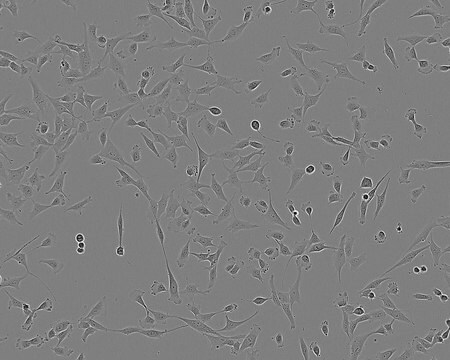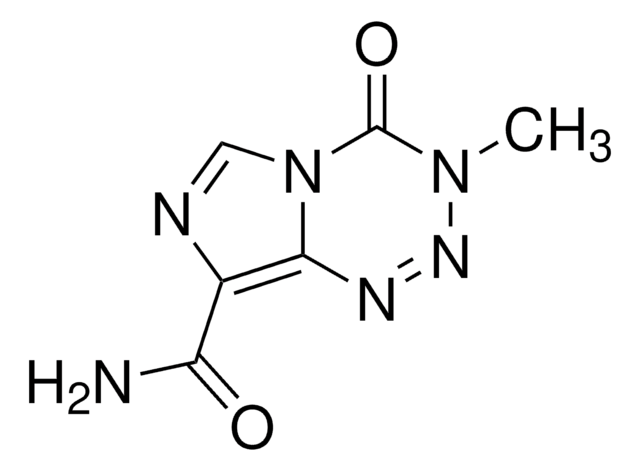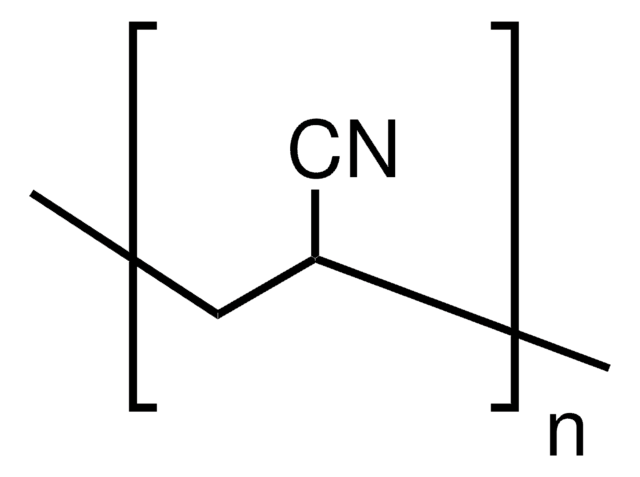830-05A
Human Mammary Epithelial Cells: HMEpC, adult
Sinônimo(s):
HMEpc cells
About This Item
Produtos recomendados
fonte biológica
human mammary glands (normal)
Nível de qualidade
embalagem
pkg of 500,000 cells
fabricante/nome comercial
Cell Applications, Inc
modo de crescimento
Adherent
cariótipo
2n = 46
morfologia
epithelial
técnica(s)
cell culture | mammalian: suitable
doença(s) relevante(s)
cancer
Condições de expedição
liquid nitrogen
temperatura de armazenamento
−196°C
Descrição geral
Mammary Epithelial Cells provide an excellent model system to study many aspects of epithelial function and disease, particularly those related to cancerogenesis.
HMEpC have been utilized in numerous research publications, for example to:
- Investigate the role of exosomes secreted by cancer cells in formation of tumor permissive microenvironment through manipulation of normal mammary epithelium (Dutta, 2014)
- Serve as control in a study investigating antitumor properties of cannabinoids (Ligresti, 2006) and stem cell microenvironment (Rostovit, 2008)
- Determine that differential expression of glycoproteins allows to classify human breast cells into normal, benign, malignant, basal, and luminal groups (Yen, 2011, 2013; Timpe, 2013)
- Identify ALDH isoform 5A1 as a potential target for treatment of human breast ductal carcinoma (Kaur, 2012); and determine that combination of an anti-EGFR anti-VEGFR treatment using ZD6474 with phototherapy (UV-B) is more effective in treating breast cancer than either treatment alone (Sarkar, 2013)
- Demonstrate that although SIRT deacetylates p53, it does not play a role in cell survival following DNA damage (Solomon, 2006)
- Demonstrate the important roles of tumor suppressor Maspin by showing that it promotes mammary epithelial differentiation via its interaction with IRF6 (Bailey, 2008); mediates effects of IFN-γ on vacuolar pH, cathepsin D processing and autophagy, protects extracellular matrix (ECM) from degradation in normal mammary epithelia, and that Maspin loss in metastatic cancer leads to unrestricted ECM degradation, contributing to metastasis (Khalkhali-Ellis, 2007, 2008); and show that loss of EcSOD expression also promotes invasiveness by disrupting ECM (Teoh-Fitzgerald, 2012, 2013)
- Investigate the role of shortened telomeres in initiation of genomic instability, cytokinesis failure and polyploidy (Tusell, 2008; Soler, 2009; Pampalona, 2012); and elucidate the role of Myc in malignancy by studying its ability to transform primary epithelial cells (Thibodeaux, 2009)
- Demonstrate, along with Human dermal Fibroblasts, that resveratrol inhibits mono-ubiquitination of histone H2B (Gao, 2011)
HMEpC, along with Human Prostate Epithelial Cells, have also been used in a study demonstrating that TGF-b1 induces Smad 1/5/8 and Smad 2/3 phosphorylation and BMP signaling results only in Smad 1/5/8 phosphorylation in these primary epithelial cells, while in cancer cells BMP also elicits Smad2/3 activation, contributing to cancerogenesis (Holtzhausen, 2013).
Characterization: the cells have a characteristic morphology consistent with an epithelial origin and are positive for epithelial cell marker cytokeratin 18.
Origem de linhagem celular
Aplicação
Componentes
Nota de preparo
- 5th passage, >500,000 cells in Cell Basal Medium containing 10% FBS & 10% DMSO
- Can be cultured at least 16 doublings
Rotina de subcultura
Exoneração de responsabilidade
Código de classe de armazenamento
11 - Combustible Solids
Classe de risco de água (WGK)
WGK 3
Ponto de fulgor (°F)
Not applicable
Ponto de fulgor (°C)
Not applicable
Escolha uma das versões mais recentes:
Certificados de análise (COA)
Lamentamos, não temos COA para este produto disponíveis online no momento.
Se precisar de ajuda, entre em contato Atendimento ao cliente
Já possui este produto?
Encontre a documentação dos produtos que você adquiriu recentemente na biblioteca de documentos.
Os clientes também visualizaram
Protocolos
Mammary Epithelial Cells and primary epithelial cells from other tissue at Cell Applications, your worldwide provider of human & animal cells, antibodies.
Nossa equipe de cientistas tem experiência em todas as áreas de pesquisa, incluindo Life Sciences, ciência de materiais, síntese química, cromatografia, química analítica e muitas outras.
Entre em contato com a assistência técnica







